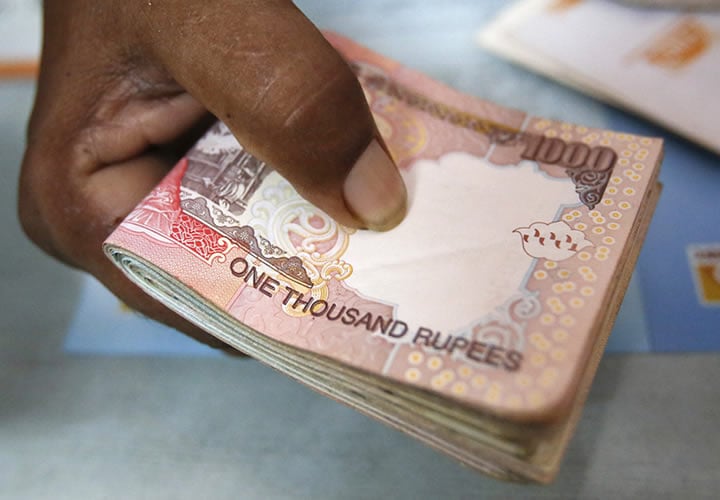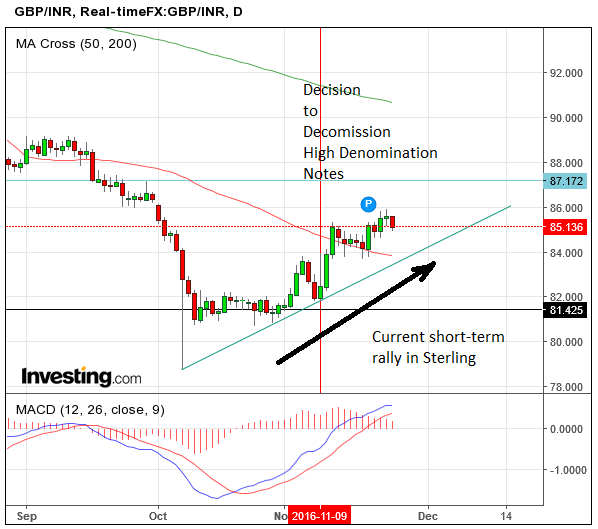Indian Rupee Forecast to Struggle into Year-End

The Pound to Rupee exchange rate's short-term uptrend was given a boost by the government’s decommissioning of 500 and 1000 Rupee notes, but it was essentially already in progress.
The Indian government’s decision to scrap high denomination notes in order to crack down on counterfeiting and money laundering has had the unintentional effect of weakening the Rupee.
On the GBP/INR price chart there is a clear spike on November 9 and 10 after the Indian government surprised markets by announcing out of the blue that it was excluding 500 and 1000 Rupee notes from legal tender.
From now on India’s awestruck populace were told they could only use the notes to pay for utility bills, debts or to deposit into their bank accounts – overnight deposits swelled.
As a consequence, Indian banks scrambled to cut interest rates in an attempt to offset the inflow be encouraging greater spending.
India’s relatively high interest rates fell, and in the topsy-turvy world of modern globalized finance the fall in interest rates led to a corresponding fall in the rupee, as investors who had liked the currency for its yield potential (high interest rates), pulled out en masse.
The effect was exacerbated by the US Presidential Election delivering a Trump victory as this began an outflow back to the US from emerging markets anyway.
“Meanwhile, foreign investors are taking profit on their holdings of Indian bonds.
“Since the US election, foreign investors have sold USD 2bn worth of onshore bonds (see chart below),” said a note from BNP Paribas highlighting India’s loss of favour in the eyes of foreign investors.
Past Glories
India had been one of the leading go-to lights in the emerging market firmament for investors seeking that rare combination of yield and stability.
With Indian bonds earning investors upwards of 6.0%, the economy taking poll position as fastest growing in the world, and the security of a more diversified economy than most EMs, Indian bonds were seen as highly attractive.
The Rupee earned the ‘carry crown’ for being the favoured play by carry traders who borrow money in a low interest rate jurisdiction where it costs them next to nothing (e.g the Eurozone where rates are 0.0%) and invest them in riskier high interest assets such as Indian bonds or their proxy NDFs.
NDF’s are Currency Forward contracts which are traded off shore, normally for currencies which are restricted to foreigners in some way, such as Rupee.
They enable traders to speculate or hedge highly regulated exotic FX.
It also fuelled an uptrend in the Rupee.
“The INR was ranked the highest EM currency in carry-to-vol terms for the better part of the last two years. As the Indian bond market is very restricted, a large portion of long INR positions held by EM investors are in the form of NDF exposures,” said Paribas’ Strategist Mirza Baig.
Demonetisation to Impact till year end
The demonetization move by the government combined with Trump outflow back to the US has broken India’s spell on investors.
The Rupee is likely to struggle to climb from here on till the end of the year when the impact of reducing circulation wears off.
“The downward pressure on interest rates is likely to persist through the end of the year, as more cash is converted into deposits,” comments Baig.
This is expected to weigh on the Rupee and has led BNP Paribas to close their long INR positions.
“The downward pressure on market rates is sharply pushing down NDF-implied yields in INR.
“This phenomenon may continue for the next one to two months, and will likely undermine the rupee via the unwinding of existing long INR carry trade exposures.
“As a result, we are closing our recommendation to sell SGD vs INR made on 10 November at 48.02,” said Baig.
Outlook for GBP/INR
The GBP/INR short-term uptrend was given a boost by the government’s decommissioning of 500 and 1000 Rupee notes, but it was essentially already in progress.
The Pound has been boosted by expectations that Brexit will not be as ‘Hard’ as previously expected, especially since high court forced the government to seek parliament’s approval for triggering article 50.
Data, such as Friday's better than expected Business Investment data for Q3 and Q3 GDP have also boosted the pound.
Rising yields in the UK have also reduced the advantage of holding emerging market bonds such as Indian bonds, further supporting the Pound.
The Pound could also benefit from safety flows from Europe in the event of increasing political instability in Europe threatening the integrity of the EU.
Given the pressure on the Rupee from demonetisation the outlook favours the Pound in the last weeks of the year.





